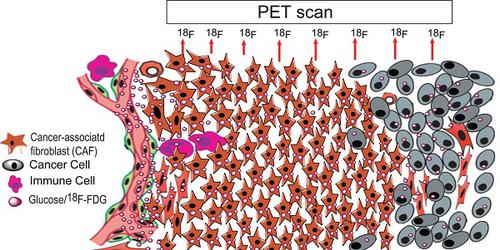当前位置:
X-MOL 学术
›
Theranostics
›
论文详情
Our official English website, www.x-mol.net, welcomes your
feedback! (Note: you will need to create a separate account there.)
Sarcoma-Targeting Peptide-Decorated Polypeptide Nanogel Intracellularly Delivers Shikonin for Upregulated Osteosarcoma Necroptosis and Diminished Pulmonary Metastasis.
Theranostics ( IF 12.4 ) Pub Date : 2018-02-02 , DOI: 10.7150/thno.18299 Suoyuan Li 1, 2 , Tao Zhang 1 , Weiguo Xu 3 , Jianxun Ding 3 , Fei Yin 4 , Jing Xu 4 , Wei Sun 1 , Hongsheng Wang 4 , Mengxiong Sun 1 , Zhengdong Cai 1, 4 , Yingqi Hua 1, 4
Theranostics ( IF 12.4 ) Pub Date : 2018-02-02 , DOI: 10.7150/thno.18299 Suoyuan Li 1, 2 , Tao Zhang 1 , Weiguo Xu 3 , Jianxun Ding 3 , Fei Yin 4 , Jing Xu 4 , Wei Sun 1 , Hongsheng Wang 4 , Mengxiong Sun 1 , Zhengdong Cai 1, 4 , Yingqi Hua 1, 4
Affiliation

|
PURPOSE
Osteosarcoma is the most common primary bone cancer and is notorious for pulmonary metastasis, representing a major threat to pediatric patients. An effective drug targeting osteosarcoma and its lung metastasis is urgently needed.
DESIGN
In this study, a sarcoma-targeting peptide-decorated disulfide-crosslinked polypeptide nanogel (STP-NG) was exploited for enhanced intracellular delivery of shikonin (SHK), an extract of a medicinal herb, to inhibit osteosarcoma progression with minimal systemic toxicity.
RESULTS
The targeted, loaded nanogel, STP-NG/SHK, killed osteosarcoma cells by inducing RIP1- and RIP3-dependent necroptosis in vitro. Necroptosis is a novel cell death form that could be well adapted as an efficient antitumor strategy, the main obstacle of which is its high toxicity. After intravenous injection, STP-NG/SHK efficiently suppressed tumor growth and reduced pulmonary metastasis, offering greater tumor necrosis and higher RIP1 and RIP3 upregulation compared to free SHK or untargeted NG/SHK in vivo. Additionally, the treatment with NG/SHK or STP-NG/SHK showed minimal toxicity to normal organs, suggesting low systemic toxicity compared to free SHK.
CONCLUSION
The STP-guided intracellular drug delivery system using the necroptosis mechanism showed profound anti-osteosarcoma activity, especially eliminated lung metastasis in vivo. This drug formulation may have great potential for treatment of osteosarcoma.
中文翻译:

肉瘤靶向肽修饰的多肽纳米凝胶在细胞内提供紫草素,用于上调骨肉瘤坏死和减少肺转移。
目的骨肉瘤是最常见的原发性骨癌,并且因肺转移而臭名昭著,对儿科患者构成重大威胁。迫切需要针对骨肉瘤及其肺转移的有效药物。设计在这项研究中,利用肉瘤靶向肽修饰的二硫键交联的多肽纳米凝胶(STP-NG)来增强紫草素(SHK)(一种草药提取物)的细胞内递送,从而以最小的全身毒性抑制骨肉瘤的进展。结果靶向的负载型纳米凝胶STP-NG / SHK通过在体外诱导RIP1和RIP3依赖性坏死病杀死骨肉瘤细胞。坏死病是一种新型的细胞死亡形式,可以很好地适应作为一种有效的抗肿瘤策略,其主要障碍是其高毒性。静脉注射后 与体内游离SHK或非靶向NG / SHK相比,STP-NG / SHK有效抑制肿瘤生长并减少肺转移,提供更大的肿瘤坏死和更高的RIP1和RIP3上调。此外,用NG / SHK或STP-NG / SHK处理对正常器官的毒性最小,这表明与游离SHK相比,全身毒性较低。结论采用坏死性机制的STP指导的细胞内药物递送系统显示出强大的抗骨肉瘤活性,尤其是在体内消除了肺转移。该药物制剂可能具有治疗骨肉瘤的巨大潜力。NG / SHK或STP-NG / SHK处理对正常器官的毒性最小,表明与游离SHK相比,全身毒性较低。结论采用坏死性机制的STP指导的细胞内药物递送系统显示出强大的抗骨肉瘤活性,尤其是在体内消除了肺转移。该药物制剂可能具有治疗骨肉瘤的巨大潜力。NG / SHK或STP-NG / SHK的治疗对正常器官的毒性最小,表明与游离SHK相比,全身毒性较低。结论采用坏死性机制的STP指导的细胞内药物递送系统显示出强大的抗骨肉瘤活性,尤其是在体内消除了肺转移。该药物制剂可能具有治疗骨肉瘤的巨大潜力。
更新日期:2018-05-01
中文翻译:

肉瘤靶向肽修饰的多肽纳米凝胶在细胞内提供紫草素,用于上调骨肉瘤坏死和减少肺转移。
目的骨肉瘤是最常见的原发性骨癌,并且因肺转移而臭名昭著,对儿科患者构成重大威胁。迫切需要针对骨肉瘤及其肺转移的有效药物。设计在这项研究中,利用肉瘤靶向肽修饰的二硫键交联的多肽纳米凝胶(STP-NG)来增强紫草素(SHK)(一种草药提取物)的细胞内递送,从而以最小的全身毒性抑制骨肉瘤的进展。结果靶向的负载型纳米凝胶STP-NG / SHK通过在体外诱导RIP1和RIP3依赖性坏死病杀死骨肉瘤细胞。坏死病是一种新型的细胞死亡形式,可以很好地适应作为一种有效的抗肿瘤策略,其主要障碍是其高毒性。静脉注射后 与体内游离SHK或非靶向NG / SHK相比,STP-NG / SHK有效抑制肿瘤生长并减少肺转移,提供更大的肿瘤坏死和更高的RIP1和RIP3上调。此外,用NG / SHK或STP-NG / SHK处理对正常器官的毒性最小,这表明与游离SHK相比,全身毒性较低。结论采用坏死性机制的STP指导的细胞内药物递送系统显示出强大的抗骨肉瘤活性,尤其是在体内消除了肺转移。该药物制剂可能具有治疗骨肉瘤的巨大潜力。NG / SHK或STP-NG / SHK处理对正常器官的毒性最小,表明与游离SHK相比,全身毒性较低。结论采用坏死性机制的STP指导的细胞内药物递送系统显示出强大的抗骨肉瘤活性,尤其是在体内消除了肺转移。该药物制剂可能具有治疗骨肉瘤的巨大潜力。NG / SHK或STP-NG / SHK的治疗对正常器官的毒性最小,表明与游离SHK相比,全身毒性较低。结论采用坏死性机制的STP指导的细胞内药物递送系统显示出强大的抗骨肉瘤活性,尤其是在体内消除了肺转移。该药物制剂可能具有治疗骨肉瘤的巨大潜力。











































 京公网安备 11010802027423号
京公网安备 11010802027423号